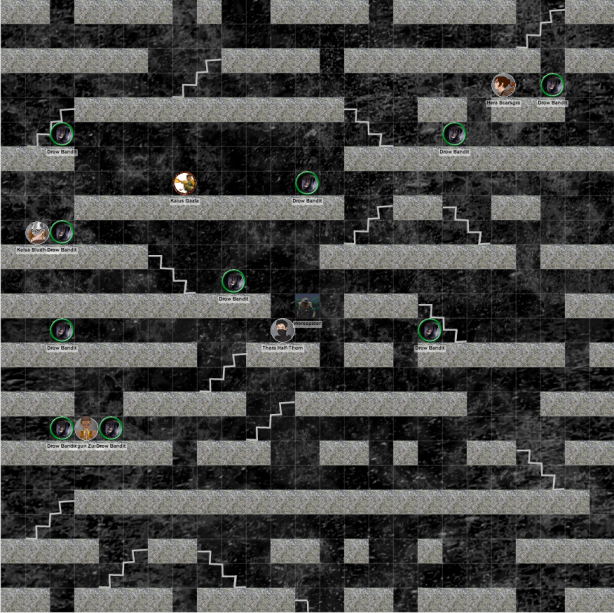Sometimes you just want to shake things up. You need to spice up combat and add a few hazards to keep players on their toes. Sometimes you want to go further and do something really crazy. In keeping with Sam Van Der Wall of RPG Alchemy‘s Blog Carnival theme, “The Combat Experience,” I’m going to show off one of my favorite encounters. One where I turned the battle mat on its side. Keep reading. You’ll see what I mean.
Mario and Luigi
When we play Dungeons and Dragons with a battle mat and miniatures we are usually dealing with two dimensions, just like most old Nintendo games. Often in D&D those two dimensions are an overhead or bird’s eye view like in The Legend of Zelda.

We see Link and octoroks as if we were above looking down on them.
Yet many other Nintendo games had a side view like Double Dragon.

We see Billy Lee kicking some butt as if we were standing to the side.
I began to imagine what a battle in a side view might look like on a battle mat. In order to get the most out of the map, I’d need the battle to have a lot of vertical levels, otherwise the encounter wouldn’t be very dynamic and all of the non-flying creatures would just hangout at the bottom of the grid. I also wanted the encounter to be contained on the battle mat. When flipping things from bird’s eye to side view, it becomes very easy to run out of map space as creatures move around. The map doesn’t follow you like a camera in a video game.
There might be a few of you who remember the old Mario Bros. game. I’m talking arcade style before the Marios were going into castles to rescue Princess Peach from Bowser. I’m talking two dudes facing off in the sewers trying to kick over as many koopa shells as possible to get some points to win a game. If Mario ran off one side of the screen, he appeared on the other (which solves my running off the map problem). It looked like this…

I’m sure the older gamers among us remember.
Well that game inspired an encounter with my players that I designed and we throughly enjoyed.
The Ladder of Insanity
The PCs had to make their way to the Underdark via a massive column known as The Ladder of Insanity. The huge column plunged miles underground and its face was marked with crumbling 5-foot wide ledges and stairs, which are just wide enough for a creatures to travel single file.
The characters found the further down The Ladder of Insanity they got, the more ruin and disrepair became obstacles. Whole sections of ledges and staircases were missing or ready to plunge into the darkness. As the PCs negotiated these hazards, a crew of drow bandits lead by a werespider appeared and attacked. The battle mat looked something like this…

Behold! The Ladder of Insanity!
Now I made that map in Roll20 and used digital tokens for the PCs instead of their beautiful array of bird’s eye view digital miniatures.

Miniature on the left, token on the right.
I recommend using tokens instead of minis in a side view encounter. You could use miniatures, but they are made specifically for bird’s eye view encounters. It is going to be more difficult for your players to wrap their minds around a side view encounter with miniatures unless you place them on their sides, but that could damage some more delicate minis.
After the map was created I wrote down a few quick mechanics for the battle.
- The map wraps around the column. So if PCs ran off one side of the map they would appear on the other. It works just like Mario Brothers of Pac Man.
- The column is curved. A creature is granted half cover from attacks made by any creature more than 20 feet away, three-quarters cover from any creature more than 30 feet away, and total cover from any creature more than 40 feet away.
- Climbing the walls at half speed requires a DC 15 Strength (Athletics) check. Creatures who fail this check by 5 or more fall onto the platform directly below their space and land prone, taking fall damage as normal.
- Jumping up and grabbing a higher platform works as normal. In order to pull itself up to the new level a creature must succeed on a DC 10 Strength (Athletics) check or end its movement in the first space it entered on the new, higher level.
- At the end of a creature’s turn if it is on one of the platforms it must roll a d20. On a roll of 1, the ground beneath its feet crumbles. The creature must make a DC 10 Reflex saving throw to jump to an adjacent unoccupied space of its choice. If it fails it falls, landing prone and taking fall damage as normal. Wherever the creature ends up after rolling a 1 it must roll another d20 to see if the new ground beneath its feet crumbles and repeat the saving throw if it gets another 1. This continues until the creature rolls a number other than 1.
Bam! There you have it. The mat is flipped and a fun encounter is had by all.
Werespider Stats
I figured I should share the drow werespider stats with all of you. This way if you want to run the encounter you can really do it up right!
Werespider
Medium humanoid (elf, shapechanger), neutral evil
Armor Class 14 in humanoid form, 15 in spider or hybrid form
Hit Points 71 (11d8 + 22)
Speed 30 ft. (clim 30 ft. in spider or hybrid form)
| STR | DEX | CON | INT | WIS | CHA |
| 13 (+1) | 19 (+4) | 14 (+2) | 11 (+0) | 13 (+1) | 12 (+1) |
Saving Throws Dex +7, Con +5, Wis +4
Damage Immunities bludgeoning, piercing, and slashing damage from nonmagical weapons that aren’t silvered
Skills Perception +4, Stealth +10
Senses darkvision 120 ft., passive perception 14
Languages Elvish, Undercommon (can’t speak in spider form)
Challenge 5 (1,800 XP)
Fey Ancestry. The werespider has advantage on saving throw against being charmed, and magic can’t put it to sleep.
Innate Spellcasitng (Humanoid or Hybrid Form Only). The werespider’s spellcasting ability modifier is Charisma (spell save DC 12). It can innately cast the following spells.
At will: dancing lights
1/day: darkness, faerie fire, levitate (self only)
Shapechanger. The werespider can use its action to polymorph into a spider-humanoind hybrid or into a giant spider, or back into its true form, which is humanoid. Its statistics, other than its size and AC, are the same in each form. Any equipment it is wearing or carrying isn’t transformed. It reverts to its true form if it dies.
Spider Climb (Spider or Hybrid Form Only). The werespider can climb difficult surfaces, including upside down on ceilings, without needing to make an ability check.
Sunlight Sensitivity. While in sunlight, the werespider has has disadvantage on attack rolls, as well as on Wisdom (Perception) checks that rely on sight.
Web Sense (Spider or Hybrid Form Only). While in contact with a web, the werespider knows the exact location of any other creature in contact with the same web.
Web Walker (Spider or Hybrid Form Only). The werespider ignores movement restrictions caused by webbing.
Actions
Multiattack. The werespider makes two attacks: two with its shortsword or one with its bite and shortsword.
Bite (Spider of Hybrid Form Only). Melee Weapon Attack: +7 to hit, reach 5 ft., one target. Hit: 8 (1d8 + 4) piercing damage, and the target must make a DC 13 Constitution saving throw, taking 9 (2d8) poison damage on a failed save, or half as much damage on a successful one. If the poison damage reduces the target to 0 hit points, the target is stable but poisoned for 1 hour, even after regaining hit points, and is paralyzed while poisoned in this way. If the target is a humanoid, it must succeed on a second DC 13 Constitution saving throw or be cursed with werespider lycanthropy.
Shortsword (Humanoid or Hybrid Form Only). Melee Weapon Attack: +7 to hit, reach 5 ft., one target. Hit: 7 (1d6 + 4) piercing damage plus 10 (3d6) poison damage.
Hand Crossbow (Humanoid or Hybrid Form Only). Ranged Weapon Attack: +7 to hit, range 30/120 ft., one target. Hit: 7 (1d6 + 4) piercing damage, and the target must succeed on a DC 13 Constitution saving throw or be poisoned for 1 hour. If the saving throw fails by 5 or more, the target is also unconscious while poisoned in this way. The target wakes up if it takes damage or if another creature takes an action to shake it awake.
Web (Spider or Hybrid Form Only). Ranged Weapon Attack: +7 to hit, range 30/60 ft., one target. Hit: The target is restrained by webbing. As an action, the restrained target can make a DC 11 Strength check, bursting the webbing on a success. The webbing can also be attacked and destroyed (AC 10; hp 5; vulnerability to fire damage; immunity to bludgeoning, poison, and psychic damage).
Reactions
Parry (Humanoid or Hybrid Form Only). The werespider adds 3 to its AC against one melee attack that would hit it. To do so, the werespider must see the attacker and be wielding a melee weapon.
Werespider Template
See “Player Characters as Lycanthropes” on page 207 of the Monster Manual.
Werespider. The character gains a Dexterity of 19 if his or her score isn’t already higher, and a +1 bonus to AC while in spider or hybrid form (from natural armor). Attack and damage rolls for the natural weapons are based on Dexterity. For the poison of the werespider’s bite attack the DC is 8 + the character’s proficiency bonus + Constitution modifier. For the Web trait the DC is 8 + the character’s proficiency bonus + Strength modifier.
PDFs!
I’ve put the werespider into a PDF for your enjoyment along with adding it to the full list of Exploration Age Monsters. You can get it in the link below or feel free to head on over to the Free Game Resources section of this site to grab it whenever you like along with tons of other monsters, D&D fifth edition rules modules, backgrounds, spells, magic items, and more.
Werespider
EA Monsters
If you like what you’re reading, please check out my podcasts on The Tome Show, follow me on Twitter, tell your friends and share this blog post, and/or leave me a comment and let me know you think. Thanks!
@ James – Great thought for a side-view encounter. I mulled over this option a long time ago when i was running a game. I thought to myself, “This idea is crazy. No one will buy into it.” I don’t know why I thought that. I probably just didn’t design a practical scenario where this could actually happen. But I’ve always really liked the idea. I definitely think it works great for some specialty underground encounters, a tower encounter, and some unique encounter where players are trying to get to the top (or bottom) of something as fast as possible.
LikeLiked by 1 person
Thanks, Sam. I thought it might not work either, but I came up with a good, specific circumstance for it. Also my players are good friends so when an idea fails, they’re pretty forgiving. It’s nice to have that safety net while taking risks.
LikeLike